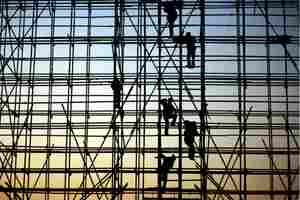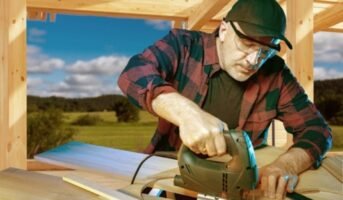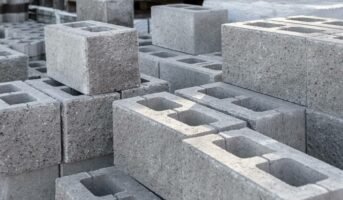All forms of construction work need the use of Scaffolding. However, different types of scaffolding systems are required due to the varying complexity of the construction work. Therefore, you must choose the appropriate scaffolding system for your construction project to provide the highest level of workplace safety. Read on to learn more about the meaning of scaffolding, its types, uses, and advantages.
What is scaffolding?
Scaffolding is merely a temporary structure used to support the original design and also serves as a platform for the construction workers to work. To construct scaffolding, workers use bamboo sticks. But, Scaffolding is different from shoring. The type of Scaffolding will vary depending on the building work being done. To support construction workers and other materials placed on it, Scaffolding needs to be strong, well-built, and well-supported. Scaffolding can be composed of steel or timber. Some Constructions, like curtain walls, don’t need scaffolding because of their nature.
Scaffolding components
Before we discuss the various varieties of scaffolding, let’s quickly go over some important terms.
Toeboards: To prevent falls, narrow, horizontal parts of the wood are placed just above the platforms.
Standards: Vertical elements that are landed to the bottom in a specific way.
Braces: The stable diagonal elements that connect with the ledgers and standards.
Ledgers: The scaffolding’s horizontal layers that move parallel along the building.
Platforms: The broad areas that employees walk on.
Putlogs: In one frame, the shorter parts that adjoin the ledger to the layout are called scaffolding.
When is scaffolding required?
A risk assessment, which is required by law whenever employees work at heights to ensure the project is done safely, is typically used to determine whether Scaffolding is essential. For example, using a ladder for low-risk tasks like minor home repairs or ground-level painting may be safe. However, a secure working platform, such as a well-designed scaffolding system, is necessary for moving around or working at height for an extended period. When Scaffolding is essential, competent tradespeople will know when it is not.
Type of scaffoldings
There are two types of Scaffolding. One is suspended, and the other is supported Scaffolding. Let us see in detail about them:-
-
Suspended scaffolding
There are two main types of scaffolding: supported scaffolding and suspended scaffolding. Using flexible elements like wires or ropes, scaffolding platforms are broken off from the ceiling, usually from a rooftop.
However, it is better to use suspended scaffolding to reach the roof of tall structures because the supporting frame can be too costly and tiresome to build. However, weight restrictions and probable horizontal reach limitations must be considered. In addition, suspended scaffolding is risky in strong winds since a swaying boarding can cause the support wires to break.
-
Catenary scaffolding
Strings or wires swing from an above-ground structure in catenary scaffolding, and these two horizontally parallel wires or cords are connected by these vertical wires or strings. Horizontal wires or ropes support a platform.
Because catenary scaffolding is immobile, it cannot be moved to a new location or adjusted to a different height.
-
Float scaffolding
Wires or ropes with fixed lengths are hung from a shaft perpendicular to the construction. Cords or wires sustain the ledgers that reinforce the platform.
It is immobile and similar to catenary scaffolding. It is likewise known as ship scaffolding.
-
Hanging scaffolding
Float scaffolding and hanging scaffolding are similar. However, scaffolding depends on two parallel lateral supports rather than just one.
-
Two-point scaffolding
Two-point scaffolding, the most popular suspended scaffolding, comprises a platform that can be rolled up and down and is supported at either end by wires or ropes.
Most often, swing stage scaffolding is visible hanging from the sides of skyscrapers.
-
Multilevel scaffolding
Each rope or wire that suspends the multilevel scaffolding from the building reinforces a ladder that is perpendicular to the building. A platform that sits on the rungs is situated between the ladders.
If the ladders are lengthy, different platforms can take it easy on them to build numerous layers, unlike all other suspended scaffolding.
-
Multipoint adjustable scaffolding
Four ropes, typically one in each intersection of the platform, suspend a platform from the top in this type of scaffolding. It can be lifted or dropped to the necessary height, making it more adjustable than the other forms of suspended structure we’ve discussed thus far.
This form of scaffolding exists widely in tanks, chimneys, stacks, and silos due to its reliability in height.
-
Needle beam scaffolding
The name refers to the needle beams connected perpendicularly to the layout. Wires or ropes that swing from the top support the beams’ outside edges. The platform then relaxes atop the needle shafts.
-
Cantilever scaffolding
This scaffolding is utilized when the ground cannot sustain a scaffolding layout, or there is an insufficient area for the platforms at meagerer levels.
Cantilever scaffolding also uses needle beams into the building’s structure and is typically attached to the inside floor. However, they don’t run perpendicular to the frame; instead, they operate at an angle to sustain the standards, which maneuver parallel and vertically.
-
Single-point adjustable scaffolding
When a window cleaner works to mop a skyscraper, they almost certainly use single-point adjustable Scaffolding. However, this type of scaffolding is adjourned by a single string or wire instead of several.
When a boatswain inspects the ship’s flank from a suspended chair, they use this type of Scaffolding, also known as boatswain scaffolding.
-
Supported scaffolding
Support scaffolding is the second type of Scaffolding, and it comprises platforms docked to the floor and supported by standards. They are therefore constructed from the bottom.
Supported Scaffolding is reliable, and certain types allow for an endless layer. Yet, it can be tricky to use if the floor is rough or a roadway restricts the footmark at the ground.
-
Frame scaffolding
It is affordable, simple to build up and take down, and most versatile. It is also understood as fabricated scaffolding and is the most used kind of supported scaffolding.
In this kind of scaffolding, the scaffolding is built entirely out of modular parts. It is often made in more than one stage but can be challenging because the base needs to be absolutely level. Therefore, frame scaffolding is preferred by residential painters and contractors.
-
Ladder jack scaffolding
A ladder Jack Scaffolding is the most basic type of scaffold that is accessible. Jack scaffolds use more than two leaning ladders angled and set against a layout. The ladder has brackets attached so it may reach perpendicularly to the building. On top of the frames parallel to the building, a platform is supported. On ladder jack scaffolding, only light freight ought to be carried.
-
Mast climber scaffolding
A mast climber scaffold is ideal for heavy weights. A vertical, attached-to-the-ground structure that resembles a ship’s mast is used to power and move a large platform. For more prominent venues, there may be a need for two masts.
-
Mobile scaffolding
This is the only scaffolding available that one can move horizontally rather than vertically. A platform rests approximately midway up the four standards, joined by guardrails and ledgers. For safety, the wheels on each measure have locks on them, and the scaffold should be utilized while the wheels are latched. One can move the Scaffolding from a platform or the ground using a motor or a manual lift.
-
Pole scaffolding
Any scaffolding structure that uses wood for every construction element is called pole scaffolding. Steel scaffolding has replaced pole scaffolding, used primarily in Asia since it is more secure, reusable, and robust.
-
Trestle scaffolding
Instead of employing standards to build trestle scaffolding, step ladders can be utilized to support a platform. Trestle scaffolding is limited to one level, unlike different scaffolds.
-
Tube and coupler scaffolding
This scaffolding is called systems or patented scaffolding and comprises many prefabricated pieces. They are held jointly with couplers. Furthermore, HAKI and Kwikstage are two prevalent systems.
Advantages of scaffolding
Scaffolding is a crucial component of the construction industry. It has been around for a while, but no matter how big the structure is, it is still an essential and life-saving structure for workers. Scaffolding not only increases safety but also simplifies construction.
Therefore, Scaffolding is necessary and makes life simpler for anyone building anything, whether they are a vast construction company or a small contractor constructing homes. Furthermore, it is essential to note that it speeds up construction, aiding businesses in meeting deadlines. Following the same path, we now look closely at several benefits of using scaffolds when constructing, renovating, or fixing any structure.
Enables Easy Access: If access to any part is denied or restricted, construction and numerous other activities become much more difficult. Scaffolding provides unrestricted access to every structure aspect, addressing a significant issue. It is beneficial when the design in question is a vast building and when support is crucial. Regardless of how high the structure is, Scaffolding creates a safe working environment. Additionally, ensuring that builders and laborers have complete access to every part of the building for operations like painting and plastering is the Scaffolding’s interconnected layout.
Provides Perfect Balance: The balance of Scaffolding is another advantage in addition to accessibility. Construction involves a lot of precision work that calls for top performance from workers. Scaffolding does a fantastic job of placing a worker on a firm foundation, which is the only possible way. In addition, workers can balance themselves in various positions since scaffolds provide a flat surface. The latter is crucial since specific parts are required for different tasks.
Ensures Safety: Few would disagree that safety is one of the main benefits of Scaffolding in construction. Work at dangerous heights (100 feet or more) may be necessary for construction workers depending on the task. The number of stories in a building determines the precise size of the Scaffolding, and the use of Scaffolding has given workers a safe working surface.
Boosts Productivity: A boost in general productivity is one of the other benefits of Scaffolding. It is a direct advantage of the higher efficiency of the improved safety and access scaffolds. In addition, productivity is sure to rise when a worker has a pleasant workplace, especially in physically demanding work like construction.
Acts A Bridge: There are various tasks associated with construction where laborers may need to take a long and meandering path to reach a certain point. It is a big waste of time and unneeded tiredness for the workers. Scaffolding gets over this problem by providing several bridge points that significantly reduce the distance that workers need to cover. These bridging points simplify construction in addition to saving time and energy.
Lasts For A Long Time: Scaffolds are durable and last a very long period. Although wooden scaffolds are gradually becoming less popular, they are also durable. However, when it comes to longevity, steel is a definite winner. The fact that it is robust and provides a high level of security is particularly significant here.
Scaffolding safety precautions
When it comes to scaffolding, safety is one of the most important things to take care of. So, here are some of the top scaffolding safety tips to keep in mind:
- Use proper safety equipment like personal protective equipment (PPE), hard hats, fall arrest equipment, and non-slip footgear.
- Keep the specific load-bearing capabilities of the scaffolding materials and design in mind to prevent it from breaking, collapsing, or cracking.
- Be aware of all the laws, standards, regulations of the area of construction to minimize risks and hazards.
- Inspect all of the scaffolding materials before construction to make sure there is no damage or defects that can cause accidents.
- Keep all the vehicles and heavy equipment clear of the scaffold base.
Scaffolding in Tamil
In the Tamil language, scaffolding is called Cārakkaṭṭu (சாரக்கட்டு).
Scaffolding in Hindi
In the Hindi language, scaffolding is known as machaan (मचान).
Scaffolding in Telugu
In the Tamil language, scaffolding is referred to as Paran̄jā (పరంజా).
Bottom line
The significance of scaffolding cannot be overstated, whether you are a homeowner wishing to renovate a portion of your house or a small builder working in the construction industry. They considerably reduce construction time while minimizing risks and increasing efficiency.
FAQs
What is the most commonly used Scaffolding?
Frame Scaffolding is the most commonly used Scaffolding.
What can I use instead of Scaffolding?
Some safe scaffolding alternatives include access towers, boom lifts, ladders, and access platforms. However, when working at heights for an extended period, the most popular and preferred solution is Scaffolding.
What are the different sizes of Scaffolding?
To fit the dimensions of standard Scaffolding, numerous sizes of scaffolding boards are available. Their most typical lengths are 8 feet, 9 feet, 12 feet, and 16 feet. So whether the span is 5 feet or 7 feet, one 8-foot board will work with either.
What is the safety of Scaffolding?
Always use a built-in ladder, internal access stairway, or fixed ladder to access the working platform. Further, above the scaffold platform, there should often be a handheld.
What are the disadvantages of metal scaffolding?
One of the main drawbacks is that you cannot install it in areas with limited space because the scaffold needs a minimum amount of width space to be erected.
Housing News Desk is the news desk of leading online real estate portal, Housing.com. Housing News Desk focuses on a variety of topics such as real estate laws, taxes, current news, property trends, home loans, rentals, décor, green homes, home improvement, etc. The main objective of the news desk, is to cover the real estate sector from the perspective of providing information that is useful to the end-user.
Facebook: https://www.facebook.com/housing.com/
Twitter: https://twitter.com/Housing
Email: [email protected]












